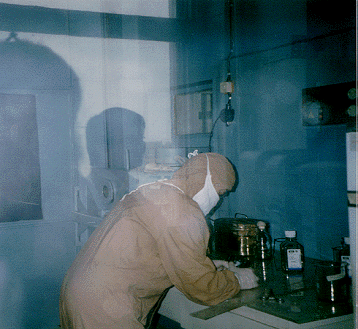|
Biological Weapons Aerosolized anthrax may seem like one of mankind's most dangerous scourges, but plague-ridden corpses are a bioterrorist's best friend.
Aerosolized anthrax may seem like one of mankind's most dangerous scourges, but plague-ridden corpses are a bioterrorist's best friend. Biological weapons have been a problem for society ever since their first recorded use... in the sixth century B.C. Despite the recent media infatuation with bioterrorism and its sibling, biowarfare, we're not exactly talking about a new idea here, either globally or in the U.S. In fact, from George Washington to George Bush, biological weapons have been part of American history. Hell, they're practically a national institution. According to the U.S. government, the earliest recorded uses of bioweapons goes back to the ancient Assyrians and the ancient Greeks, who used medicinal herbs to wreak havoc before the Christian era began. Another early adopter was the Mongol horde, which threw plague-infested corpses over the walls of a Crimean fortress they happened to be beseiging in the 14th century. This was perhaps history's most devastating use of biological warfare, seeing as it may have caused the Great Plague (in addition to very effectively wiping out its target). Granted, there's a limit to the effective delivery of plague corpses, especially in the age of intercontinental ballistic missiles. But that didn't stop people from trying, right up until the Industrial Revolution (the Russians allegedly used this strategy to attack the Swedes in the 18th century, perhaps accounting for Sweden's otherwise inexplicable failure to achieve global dominance). In the Western hemisphere, Native Americans were among the earliest mass victims of biowarfare, part of the campaign to clear up the ownership of the "New World" on behalf of invading Spanish, French and British forces. Spanish Conquistador Francisco Pizarro brought Christianity to the heathens of South America, and he generously decided to make sure they got to meet Jesus before he did, by offering them gifts of clothing infested with smallpox pus.
According to Pox Americana, a history of smallpox in the United States, George Washington just coincidentally happened to inoculate his troops against the disease during that conflict (against the explicit standing orders of the British Army). God bless America! After the American revolution, biological warfare went into a "quiet period" as the mass of humanity focused on curing the major diseases before they obliterated civilization. It wasn't until the 20th century that the generals once again decided that guns just didn't kill enough people fast enough. During World War I, German agents tried to infest livestock destined for its enemies with anthrax and a nasty little disease called "glanders," which (as you may have guessed) has something or other to do with glands. The fun just kept on coming. During World War II, Japan decided to get in on the act, with a Manchurian facility devoted to the efficient Japanese manufacture of deadly biotoxins. Thousands of prisoners were killed by innovations such as aerosolized anthrax, which is one of the modern world's most hyped bio-threats. Not to be left out, the U.S. launched a bioweapons program in 1943. Among the bio-agents the government admits to stockpiling are anthrax, botulism, encephalitis, Coxiella burnetii, Brucella suis, and Staphylococcal enterotoxin B. Richard M. Nixon "officially" ordered the country's "offensive use" stockpiles destroyed with the word "officially" in this case bearing all the connotations of secretive avoidance one might suspect, and the "offensive" loophole leaving lots of room for "defensive" reseach. After all, there was a Cold War on, and the Soviet Union wasn't letting the Americans have all the fun with boils, pus, flesh-eating and the like. Chernobyl gets all the press, but in a little-discussed 1979 incident, a Soviet biowarfare laboratory had an accidental explosion which resulted in the release of anthrax spores (probably) in the city of Sverdlovsk. The Soviet government blamed contaminated meat for the subsequent outbreak (but Boris Yeltsin subsequently admitted it was a biowarfare experiment gone bad). The numbers were obscured because of Cold War secrecy, but it's believed 200 to 1,000 people died. Funerals were canceled, and the bodies were sterilized and disposed of as biohazards.
The most notable beneficiary of America's defensive research was, of course, Saddam Hussein. Back in the 1980s, Iraq's dictator was considered a beloved ally of freedom. As such, Hussein was entitled to receive, from time to time, little gifts, such as strains of aerosolized anthrax, smallpox and bubonic plague, carefully manufactured and refined in U.S. government laboratories. Not surprisingly, it's believed that some of these samples may have found their way onto the black market and eventually fallen into the hands of Terrorist Organizations such as al Qaeda. After the invasion of Afghanistan in 2002, U.S. forces found at least one al Qaeda facility devoted to biological weapons research, which may have been connected to a series of terrorist incidents in late 2001, in which powderized anthrax was mailed to government officials and members of the media, resulting in more than 20 infections and four deaths. The jury is still out on whether the attack was an al Qaeda plot or just another case of egotistical acting out by a disgruntled federal employee. The world is still feeling the effects of the superpowers' romance with biowarfare today. A recent outbreak of Severe Acute Respiratory Syndrome, a particularly contagious and lethal form of pneumonia, sparked much speculation and fear about the disease's possible origins, although there is currently no evidence to suggest an artificial cause. The full extent of the biological weapons threat is unknown. Since the U.S. regime is still functioning (as of this writing), there is little information on the breadth and nature of American biowarfare research. The collapse of the Soviet Union, however, provided great insight into the dangers of such programs, while also facilitating the worldwide spread of such technology.
CNS reports that some sites worked with strains of anthrax, tularemia, brucellosis, plague, typhus, Q fever, smallpox, botulinum toxin, Venezuelan equine encephalitis, Rinderpest virus, Newcastle disease virus, African swine fever virus, sheep pox virus, goat pox virus, fowl pox virus, blue-tongue virus, herpes, and cereal rust fungi. They tested various lethal and sublethal strains on horses, monkeys, sheep, donkeys, mice, guinea pigs and hamsters. In addition to the donkeys and hamsters, there was an occasional bout of "accidental" experimentation on local residents (both human and animal). Of course, all these lovely diseases are now available on the black market for the right price, about as well accounted-for as the Soviet's nuclear weapons materials. According to CNS, when the Russians mothballed an island-based biological warfare facility in 1992, local residents "flocked to the island to seize abandoned military equipment that the Russian forces had been unable to take with them. It is to be hoped that the looting occurred in the safer, residential part of the island." The end of the Russian biowarfare research program (a development motivated less by right-minded compliance with international law than by financial collapse) led many former Soviet scientists to seek new and glamorous careers overseas. It must be tough for them to decide where they want to live. Prospective new employers include Algeria, China, Cuba, Egypt, Ethopia, Iran, Israel, Libya, Myanmar, North Korea, Pakistan, Sudan, Syria, Taiwan, and/or Vietnam. And that's not even counting the nations that have publicly disavowed their "past" love affairs with biowarfare, such as the U.S., the U.K., Russia, Japan, France, Germany, India, Italy, South Korea and South Africa. Even Canada has conducted biowarfare research, including the production of weaponized anthrax, and research into brucellosis, rocky mountain spotted fever, plague, tularemia, typhoid, yellow fever, dysentery, rinderpest and botulism. Given the sheer number of programs and the massive quantities of research and supplies completely unaccounted for, it will frankly be a miracle if we don't see some sort of biowarfare-related epidemic in the next 20 years. But, stockpiling enough medicine to provide full-strength smallpox vaccines for the entire country is just another pork-barrel project by those big spenders in Washington, right? We've got more important things to do with that money, like spending $2 billion a year to subsidize the sugar industry, something like a couple billion a year in direct subsidies to wealthy oil barons (not counting the current war in Iraq), and special tax credits for companies that burn chicken droppings to generate electricity. After all, you've got to have priorities...
|
 Knowing a winning strategy when they saw it, the British borrowed the tactic for use in North America as well, as part of a strategic initiative to wipe out Indians collaborating with the French. In both these cases, the beloved forefathers of the modern Americas succeeded in creating nearly
Knowing a winning strategy when they saw it, the British borrowed the tactic for use in North America as well, as part of a strategic initiative to wipe out Indians collaborating with the French. In both these cases, the beloved forefathers of the modern Americas succeeded in creating nearly  With threats like this, it certainly makes perfect sense for the United States to maintain that "defensive program," which continues through this day. The problem with the "defensive" program, of course, is that biological samples suitable for use in the manufacture of bioweapons keep "accidentally" finding their way into the hands of guys who are really offensive.
With threats like this, it certainly makes perfect sense for the United States to maintain that "defensive program," which continues through this day. The problem with the "defensive" program, of course, is that biological samples suitable for use in the manufacture of bioweapons keep "accidentally" finding their way into the hands of guys who are really offensive.  The Soviets had several facilities researching biological weapons, starting in the 1920s with a military controlled program and enhanced in the 1970s with secret research by intelligence agencies, according to the Center for Nonproliferation Studies. Studies focused on biotoxins and diseases dangerous to humans, livestock and crops. These facilities were sufficiently large and insulated to have their own daycare centers and cafeterias.
The Soviets had several facilities researching biological weapons, starting in the 1920s with a military controlled program and enhanced in the 1970s with secret research by intelligence agencies, according to the Center for Nonproliferation Studies. Studies focused on biotoxins and diseases dangerous to humans, livestock and crops. These facilities were sufficiently large and insulated to have their own daycare centers and cafeterias. 